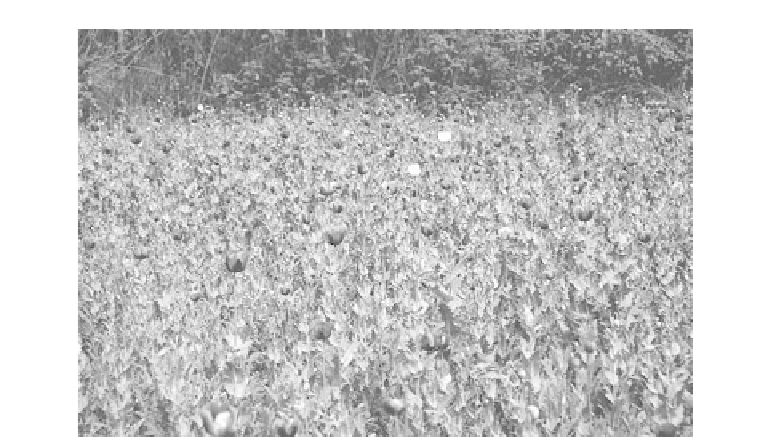Geography Reference
In-Depth Information
Figure 15-7
Opium poppies in the Golden T Triangle in northern
Laos.
Photograph courtesy of B. A. Weightman.
Khun Sa' s turf has been taken over by the United Wa
State Army , a splinter group of the Burmese Communist
Party in northern Shan state. This group maintains a
cease fire with the Yangon regime and has formed a mili-
tia to protect both their interests. The United Wa Army
comprises an ethnic minority of about 20,000. Their lin-
gua franca is Chinese. Having links to opium poppy
growers in the region as well as in China, they control
the largest narcotic trafficking organization in Southeast
Asia. China provides the group with arms.
While drug “kingpins” operate heroin and metham-
phetamine factories, they also build infrastructure for the
local people to ensure their support. Drug earnings have
funded roads, schools, and clinics in the otherwise
poverty-stricken region. For these residents caught in the
cycle of poverty and repression that is modern Burma
and largely isolated from the outside world, drug money
has become the primary engine of state-building in the
Wa “state.”
Since the 1980s, a new string of refineries has been
established in the Shan state close to the Chinese drug
market and with links to new markets abroad. One new
market is Taiwan, which in 1989 was virtually drug
free. Now drug abuse is a major concern. Drug use is
increasing in Vietnam, Bangladesh, and India. There
are more than 700,000 Burmese heroin addicts, 70 per-
cent of whom have HIV . There are at least half a million
addicts in Thailand, and 14 percent of Malaysian
teenagers are now using hard drugs. China counts at
least 250,000 addicts, with Y unnan having the highest
rate of addiction.
Heroin and other drugs from Burma reach interna-
tional markets via land and sea. Most drugs travel over-
land via Y unnan or Guangxi in China to ports along the
eastern seaboard. Drugs are carried by people of all ages
who have little other means to earn a living. At times
when the Chinese government is cracking down on this
illegal trade, the drugs are shipped by fishing trawlers to
the Chinese ports.
For years, Thailand was the main conduit for
drugs, but stepped-up law enforcement and poppy pro-
duction alternative programs have altered this pattern.
Cambodia and Laos have emerged as major transit
routes. Cambodia is also a key center for money laun-
dering. Drug laws are vague in Cambodia, and mari-
juana is freely available in markets. Cambodia is also a
major shipper of marijuana. In addition, after years of
war, Cambodia has become a major source of arms for
the Golden T riangle' s drug lords. Cambodia' s deep-wa-
ter ports at Koh Kong and Kompong Som, with their
hundreds of fishing trawlers, make it easy for drug
runners to smuggle the drugs to larger ships in the inter-
national distribution web. Cambodia handles about
15 percent of Burma' s heroin production. In Laos, drug
smuggling is protected by the Mountainous Area Devel-
opment Corporation, a company controlled by the
Laotian army .
Another new trail is from Burma and northern
Thailand via northern Laos into Vietnam via Hanoi and
the port of Haiphong. Danang is another distribution
point. Vietnam, like its neighbors, has a long history of
opium smoking among ethnic minorities in mountainous

















Search WWH ::

Custom Search